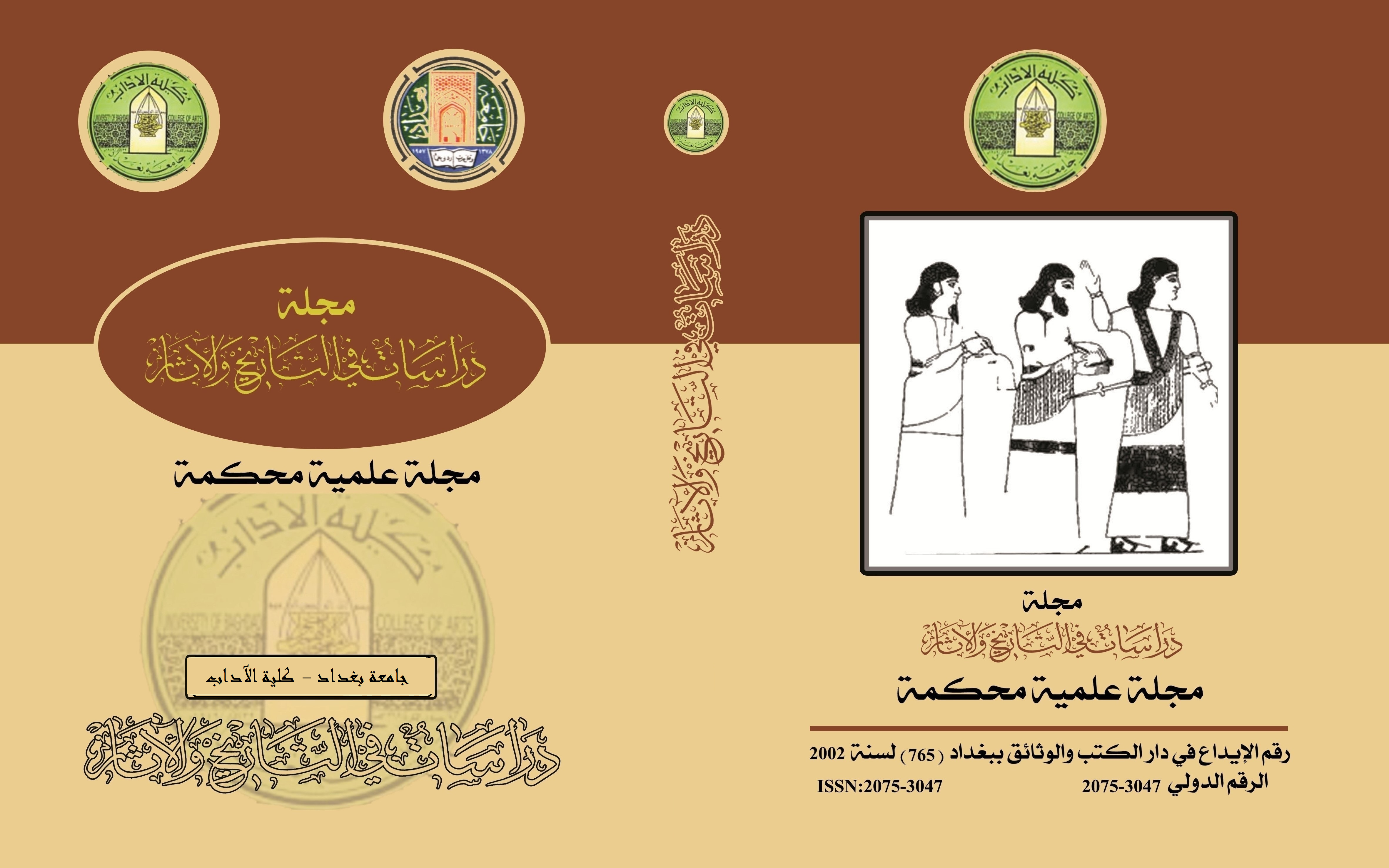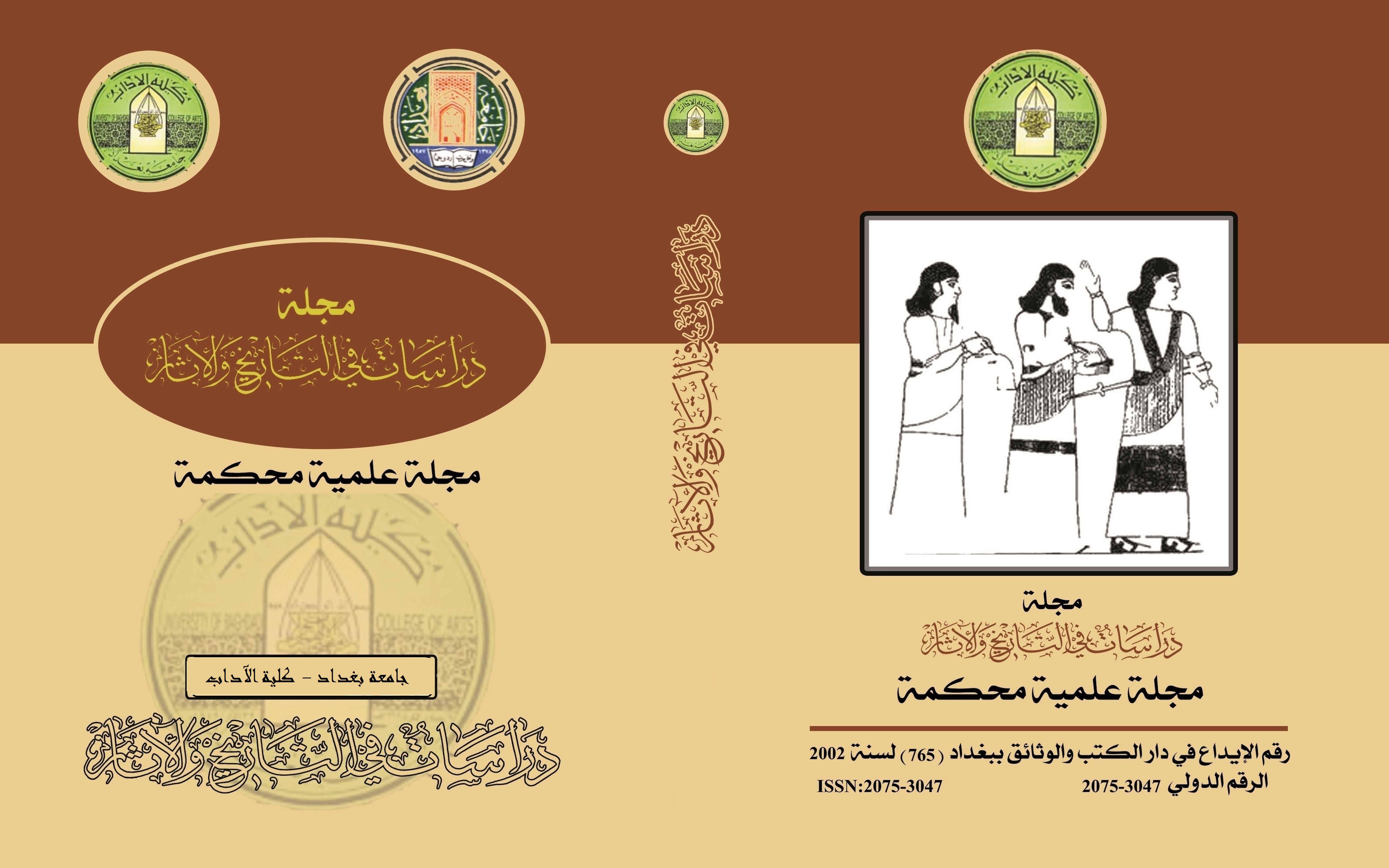آلة الطبل الايقاعية في حضارة بلاد الرافدين
الكلمات المفتاحية:
الطبل، الايقاع، بلاد الرافدينالملخص
لقد أفرزت لنا حضارة بلاد الرافدين العديد من المظاهر الحضارية المهمة والتي كانت نتاجات عمل الإنسان عبر مر العصور، فقد تفاعل الإنسان العراقي القديم مع البيئة التي يعيش بها واحاط بكل مقوماتها الايجابية والسلبية، واستطاع ان يتعامل معها بما يضمن له استمرار بقائه ونموه.
وابتداءً من العيش في الكهوف وصولا إِلى سكنه في بيوت مستقله، اختط هذا الإنسان عبر هذه المراحل نظما لحياته بتفاصيل دقيقة ومهمة ابرزتها لنا نتائج التنقيبات الأثرية التي شرعت في العديد من المواقع الأثرية القديمة، وكذلك ما أفرزته لنا الكتابات المسمارية من مضامين حضارية متنوعة ومهمة ساعدت دراستها في إعطاء صورة واضحة عن حياة بلاد الرافدين سواء اكانت متعلقة بالجانب الديني وهو الأكثر شيوعا أو الدنيوي.
وفي ضوء استقراء النصوص المسمارية التي تضمنت مواضيعها ألونا متنوعة من حضارة بلاد الرافدين ابتداءً من النصوص الدينية التي أفرزت لنا معلومات مهمة عن ديانة بلاد الرافدين وأهم الآلهة التي عبدت في هذه الحضارة وأهم المعابد التي بنيت وأهم الممارسات والطقوس الدينية التي مارسها سكان بلاد الرافدين ارضاءً لآلهتهم وطلبا للسلامة والأمن والازدهار، وصولا إِلى النصوص الاقتصادية التي أفرزت لنا واقع الحياة اليومية الاقتصادية التي مورست في هذا البلد المعطاة.
وفي ضوء التنوع الحضاري الذي اتسمت به حضارة بلاد الرافدين واصالتها وتأثيرها على الحضارات الأُخرى، ارتأى الباحث ان يشرع بموضوع الموسيقى وتأثيرها ودورها في حضارة بلاد الرافدين وتحديدا جزئية منها وهو آلة الطبل الموسيقية؛ إِذْ مارس سكان بلاد الرافدين العزف على الآلات الموسيقية وكذلك مارسوا الغناء المصاحب لهذه الموسيقى، وكان لهم دوافع عديدة لهذه الممارسات بيد أن أهم هذه الدوافع كان الدافع الديني بحسب ما أوردته لنا النصوص المسمارية المتنوعة والتي حوت في مضامينها الموسيقى والآلات الموسيقية المتعددة وما يرتبط بها من معلومات قيمة عرفتنا بهذا اللون الحضاري المهم وانعكاساته على المجتمع في حضارة بلاد الرافدين وكذلك عززت لنا الفهم العام للموسيقى والآلات الموسيقية وما يرتبط بها من موروث حضاري كان ولايزال مستعملا حتى وقتنا الحاضر.
تأتي أُهمية دراسة الموسيقى والآلات الموسيقية من خلال ارتباطها ارتباطا وثيقا بوجدان ومشاعر الإنسان وارتباطها أيضاً بالجانب الديني الذي كان وما يزال مؤثرا وموجها لحياة الإنسان.
اتبع الباحث الأسلوب النظري في منهج البحث العلمي المعتمد بالدرجة الأساس على ما تضمنته النصوص المسمارية من معلومات ترتبط بنحو أو بآخر بالموسيقى والآلات الموسيقية ومنها على وجه الخصوص آلة الطبل.
المراجع
المصادر العربية:
-الاسود، حكمت بشير مجيد، (2002). ادب الرثاء في بلاد الرافدين في ضوء المصادر المسمارية، رسالة ماجستير غير منشورة، جامعة الموصل، كليّة الآداب، قسم الاثار.
-امين، سعد عمر محمد، (2005). القرابين والنذور في العراق القديم، رسالة ماجستير غير منشورة، جامعة الموصل، كليّة الآداب، قسم الاثار.
-جواد، عذراء كامل،(2018). الوصف والتشبيه في الحوليات الاشورية الملكية خلال العصر الاشوري الحديث 911-612 ق.م، رسالة ماجستير غير منشورة، جامعة بغداد، كليّة التربية ابن رشد، قسم التاريخ.
-رشيد، صبحي انور، (1970). تاريخ الآلات الموسيقية في العراق القديم، بيروت.
-السعدي، حسين عليوي عبد الحسين، (1918). وظائف الالهة في بلاد الرافدين، اطروحة دكتوراه غير منشورة، جامعة بغداد، كليّة الآداب، قسم الاثار.
-سعيد، صفوان سامي،(2009). ”التشبيه في الحوليات الاشورية“، مجلة القادسية للعلوم الإنسانية، المجلد 12، العدد.
-القيسي، محمد فهد حسين، (2006). قصص الخليقة في العراق القديم بين المعطيات المسمارية والكتاب المقدس والقـــرآن الكريــم، رسالة ماجستير غير منشورة، جامعة واسط، كليّة التربية، قسم التاريخ.
-لابات، رينيه، (1968) "الطب البابلي والاشوري"، مجلة سومر، العدد24.
-الماجدي، خزعل، (1998). الدين السومري، عمان.
-المعموري، فاطمة عباس، وفهد، سعد سلمان،(2012) ”شجرة الطرفاء في ضوء الكتابات المسمارية “، مجلة اثار الرافدين، المجلد السادس، الجزء الثاني.
المصادر الاجنبية:
Black, Jand Green, A., (1992).Gods, demons and symbols of ancient Mesopotamia, London .
Bottéro, J, (2004).The Oldest Cuisine in the World: Cooking in Mesopotamia, Chicago.
Brunner,C.J.,(1980)“The Fable of the Babylonian Tree Part I: Introduction”, Journal of Near Eastern Studies, Vol. 39, No. 3.Jul.
Christiaan,V.N., (1997).Elementary education at Nippur. The lists of trees and wooden objects, University of Groningen.
Clay,A.T.,(1975).Epic,hymns,omen and other texts,yale university,1923.( BRM,4).
Cooper,J.S., “The Conclusion of Ludlul II”, Journal of Cuneiform Studies, Vol. 27, No. 4 ,Oct.
_________,,(1978).The return of ninurta to nippur,Roma.
Dangin,F.T, (1925).Les cylinders de goudea,Paris,(TCL,13).
Dumbrill,R.J.,(2005).The Archaeomusicology of the Ancient Near East,Canada.
Ebeling,E., (1910)Keilschrifttexte aus assur religiosen in halts,Leipzig.
_________, (1931).Tod und leben nach den vorstellungen der babylonien ,Leipzig (TuL).
Gabbay, U., (2008).“The Akkadian Word for Third Gender: The kalû (gala) Once Again,”,Studies in Ancient Oriental civilization,Vol. 62, Chicago.
_________,,“(2018).Drums, Hearts, Bulls, and Dead Gods: The Theology
of the Ancient Mesopotamian Kettledrum”, Journal of Ancient near Eastern Religions,Vol. 18.
Gabbay,U.,(2014).“The kalû Priest and kalûtu Literature in Assyria”, ORIENT, Vol. 49.
Gadd, c. j., (1926).Cuneiform texts from Babylonian tablets in the british museum, London, (CT,39).
Gelb, I, J, and others, (1964ff).the Assyrian dictionary, Chicago .(=CAD).
Goodnick,J.,and others, (2014). Music in Antiquity: The Near East and the Mediterranean, Berlin.
ḫar-ra=ḫubullu,Teblets V-VII,Rome,1959.
Haupt,P.,(1992).Akkadische und summerische keilschrifttexte,Leipzig.
Henshaw,R.A.,(1994).Female and Male: The Cultic Personnel: The Bible and the Rest of the Ancient near east,Pickwick Publication.
Hinke,W.J., (2009). A New Boundary Stone of Nebuchadrezzar I from Nippur with a Concordance of Nebuchadrezzar I,U.S.A.
Hurowits,V.,(1992).I Have Built You an Exalted House: Temple Building in the Bible in Light of Mesopotamia and northwest semitic writing,England.
Izumi,Y, (1994).Oaths in Sumerian archival texts:A case study of Ur III Nppur,Yale university.
James,P.,and others, (2008).“Ziggurats, Colors, and Planets: Rawlinson Revisited”, Journal of Cuneiform Studies ,Vol. 60.
Keiser, C. E., (1918).Letters and Contracts From Erech Written In The Neo-Babylonian Period, New Haven, London, Oxford ,(BIN,1),
Kohen,M.E.,(1988). Sumerian Hymnology: The Eršemma. Hebrew Union College Annual Supplements ,2. Cincinnati: Hebrew Union College.
Kutzer,E.E.,(2017).The Socio-Cultural Value and Function of Music,,unich.
Kwasman,T.,(1959).Neo-Assyrian Legal Documents in the Kouyunjik Collection of the British Museum,Roma,1988.ḫar-ra=ḫubullu,Teblets VIII-XII, Romem.
Lambert, W.G., and Millard, A.R., ATRA-¬ASÏS,(1969).The Babylonian Story of the Flood, Oxford,(Lambert Millard Atra-ḫasis).
_________,, (1960).Babylonian Wisdom Literature,,Oxford.
Landsberger,B., (1959).Materialien zum sumerischen lexicon,Band,7,The series
Langdon, S., (1929).Babylonian penitential psalms, London . (OECT,Vol.6).
_________,.,“ (1934). Babylonian and Hebrew Demonology with reference to the supposed borrowing of Persian Dualism in Judaism and Christianity”, Journal of the Royal Asiatic Society Of Great Britain and Ireland,Vol.66.
Linssen, M. J. H.,(2004).The Cults of Uruk and Babylon: The Temple Ritual Texts As Evidence for Hellenistic cult, Leiden.
Liverani, M, (1988).The Ancient Near East: History, Society and Economy, London and new yourk.
Mariana, G., (2007).The Assyrian Sacred Tree: A History of Interpretations, Germany.
Masculinities and Third Gender, (2016).The Origins and Nature of an Institutionalized Gender Otherness in the Ancient Near East, Alter Orient und Altes Testament, Band 435,Munster.
McCormick,C., (2012).Palace and temple, A Study of Architectural and Verbal Icons,Deutsch.
Meier,G.“,(1944).Die zeweite tafel der serie bīt mēseri”, Archiv für Orientforschung, band 14.
Mercer,S.A.,(1913).“The Oath in Cuneiform Inscriptions“,Journal of the American Oriental Society, Vol. 33 .
Messerschmidt,L., (2014).Keilschrifttexte aus Assur historischen Inhalts,Leipzig,
Mirelman,s., The Ala-Instrument: Its Identification and Roles,Magnes Press.
Mittermayer,C.,(2019).“Was sprach cler eine zum anderen?”,Erganzung sbande zum zeitschrift fur Assyriology und Vorderasiatische Archaologie,Band,15.
Nissinen, M., (2003).Prophets and Prophecy in the Ancient Near East,Atlanta.
Otten,V.,(1978).“Textanschlüsse und Duplikate von Boğazköy-Tafeln”, ZA, Vol.68.
Pollock, S.,( No Date).“Chronology of the Royal Cemetery of Ur”, Iraq, Vol.47, 985.
Pongrantz-leisten, B, and Sonik, K, (2015).The Materiality of Divine Agency, Berlin.
Ragavan,D., (2013). “ Entering Other Worlds: Gates, Rituals, and Cosmic Journeys in Sumerian Sources”, The university of Chicago,oriental institute seminars, Number, 9,Chicago.
Raine, A.F., (2015).The El-Amarna Correspondence (2 vol. set): A New Edition of the Cuneiform, Leiden.
Reiner,E.,and Civil,M, (1969).Materialien zum sumerischen lexicon,Band ,12, Roma.
Richard,H.A.,(1994). Female and Male: The Cultic Personnel: The Bible and the Rest of the Ancient near east,USA.
Rochberg, F., (1996). Before Nature: Cuneiform Knowledge and the History of Science, Chicago.
Rosen,R.M.,(2004).Time and Temporality in the Ancient World,Pennsylvania.
Scheil,V.,(1900).Mémoire de la delegation en perse,Vol.2,Paris.
Schramm,W., (2008).Ein Compendium sumerisch-akkadischer Beschwörungen, Göttinger Beiträge zum Alten Orient, Band 2,Deutsche.
Stephan,M.,and Hooper,L., (2020). Figurines in Hellenistic Babylonia: Miniaturization and Cultural Hybridity,Camberidge.
Strommenger E, and Hirmer M, Funf Jahrtausende.(1961). Mesopotamien, Verlag, 1962,Fig.241;Parrot, A.,Assur, Paris.
Thompson, R. C., . (1911). Cuneiform Texts from Babylonian Tablets in the British Museum, London. (=CT,16),
Thureau-dangin,F., (1921). Rituels accadiens,paris.
Tinney,S., (1996).The nippur lament,Philadelphia.
Van der spek,RJ, (2004). “palace, temple and market in Seleucid Babylonia”,Topoi,Supp. ,Vol.6.
Weidner,E.F., (1959). Die inschriften Tukulti-Ninurtas I und seiner nachfolger, German.(AFo,12).
Woolley,C.L., (1934). Ur Excavation, the royal cementery, New York.
Zaia,S.,( 2019).“Kings, Priests, and Power in the Neo-Assyrian Period”, Journal of Ancient Near Eastern Religions,Vol.19,Brill.
Zimmern,H., (2018).Beiträge zur kenntnis der babylonischen religion, Germany.
التنزيلات
منشور
إصدار
القسم
الرخصة

هذا العمل مرخص بموجب Creative Commons Attribution 4.0 International License.
:حقوق الطبع والنشر والترخيص
بالنسبة لجميع البحوث المنشورة في مجلة دراسات في التاريخ والآثار، يحتفظ الباحثون بحقوق النشر. يتم ترخيص البحوث بموجب ترخيص Creative Commons CC BY 4.0 المفتوح ، مما يعني أنه يجوز لأي شخص تنزيل البحث وقراءته مجانًا. بالإضافة إلى ذلك ، يجوز إعادة استخدام البحث واقتباسه شريطة أن يتم الاستشهاد المصدر المنشور الأصلي. تتيح هذه الشروط الاستخدام الأقصى لعمل الباحث وعرضه.
:إعادة إنتاج البحوث المنشورة من الناشرين الآخرين
من الضروري للغاية أن يحصل الباحثون على إذن لإعادة إنتاج أي بحث منشورة (أشكال أو مخططات أو جداول أو أي مقتطفات من نص) لا يدخل في نطاق الملكية العامة أو لا يملكون حقوق نشرها. يجب أن يطلب الباحثون إذنًا من مؤلف حقوق النشر (عادة ما يكون الناشر).
يطلب الإذن في الحالات التالية:
بحوثك الخاصة المنشورة من قِبل ناشرين آخرين ولم تحتفظ بحقوق النشر الخاصة بها.
مقتطفات كبيرة من بحوث أي شخص أو سلسلة من البحوث المنشورة.
استخدم الجداول والرسوم البيانية والمخططات والمخططات والأعمال الفنية إذا لم يتم التعديل عليها.
الصور الفوتوغرافية التي لا تملك حقوق لنشرها.
لا يطلب الإذن في الحالات التالية:
إعادة بناء الجدول الخاص بك مع البيانات المنشورة بالفعل في مكان آخر. يرجى ملاحظة أنه في هذه الحالة يجب عليك ذكر مصدر البيانات في شكل "بيانات من ..." أو "مقتبس من ...".
تعتبر عروض الأسعار القصيرة معقولة الاستخدام العادل ، وبالتالي لا تتطلب إذنًا.
الرسوم البيانية ، الرسوم البيانية ، المخططات ، الأعمال الفنية التي أعاد الباحث رسمها بالكامل والتي تم تغييرها بشكل ملحوظ إلى درجة لا تتطلب الاعتراف.
الحصول على إذن
لتجنب التأخير غير الضروري في عملية النشر ، يجب أن تبدأ في الحصول على أذونات في أقرب وقت ممكن. لا يمكن لمجلة الآداب نشر بحث مقتبس من منشورات أخرى دون إذن.
قد يمنحك مالك حقوق الطبع والنشر تعليمات بشأن شكل الإقرار الواجب اتباعه لتوثيق عمله ؛ بخلاف ذلك ، اتبع النمط: "مستنسخ بإذن من [المؤلف] ، [كتاب / المجلة] ؛ نشره [الناشر] ، [السنة]." في نهاية شرح الجدول ، الشكل أو المخطط.



















